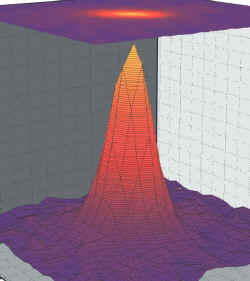Single Atoms on Demand

Quantum computers of the future may rifle through calculations by altering the quantum states of scores of atoms confined within clever traps. However, atomic physicists must first learn how to place a few neutral atoms into such traps and control their tendencies to escape or randomly change their quantum states during the manipulation. In the 30 October PRL, German researchers report that they successfully transferred an exactly known number of cesium atoms from a trap that uses lasers and magnetic fields into a calmer snare that uses only a single laser beam. The technique holds promise as a source of one well-behaved atom at a time.
Both traps are popular tools for atomic physicists. The first, called a magneto-optical trap, or MOT, relies on radiation pressure from several laser beams to confine atoms within a magnetic field. Atoms absorb photons from the lasers and then re-emit photons in random directions. This process slows the atoms until they settle in a cold knot at the center of the magnetic field. By contrast, the second trap uses a single laser. In this so-called optical dipole trap, the oscillating electric field of the laser polarizes neutral atoms and attracts them, just as a charged plastic rod attracts neutral hairs or paper shavings. The attraction is highest at the sharp focal point of the laser beam. An optical trap is more fragile than a MOT, but atoms linger more quietly there because the laser is tuned to a frequency at which the atoms do not absorb photons.
Physicists have shuffled neutral atoms between the two traps, but not with high efficiency or with precise knowledge of how many atoms were confined. The new study by Daniel Frese and his colleagues at the University of Bonn accomplished both feats. The team aligned the centers of their MOT and optical dipole trap with unprecedented precision and made the MOT unusually small, so that the trap sizes were similar. They first isolated a few cesium atoms within the MOT, confining them with a strong magnetic field to a clump about 10 µm wide. Fluorescent emissions from the atoms, measured by a sensitive photon detector, revealed the number of trapped atoms–usually between 1 and 10. Then they switched on the optical dipole laser and switched off the MOT system a few milliseconds later. All of the atoms stayed trapped, suspended by the laser light alone. When the team switched the MOT back on, the fluorescent emissions showed that none of the atoms fled for times as long as one minute.
The team’s next step is to transport the trapped atoms a few millimeters to another device, such as a cavity containing one photon. Coauthor Victor Gomer envisions such a system as a ready source of atoms for experiments in quantum information processing. “It will be possible to deliver a given number of atoms on demand,” Gomer says. The gentleness of the optical dipole trap will let researchers manipulate the atomic states of such atoms and observe their quantum dynamics for many seconds–hardly possible in a MOT.
”I’m absolutely delighted with this paper,” says retired physicist Arthur Ashkin of Bell Laboratories/Lucent Technologies in Holmdel, New Jersey. The technique should make it possible to study controlled interactions between single atoms and single photons, says Ashkin, who pioneered the optical dipole trap. “This is quantum mechanics at its ultimate. I think the community will jump on it.”
–Robert Irion
Robert Irion is a freelance science writer based in Santa Cruz, CA.


